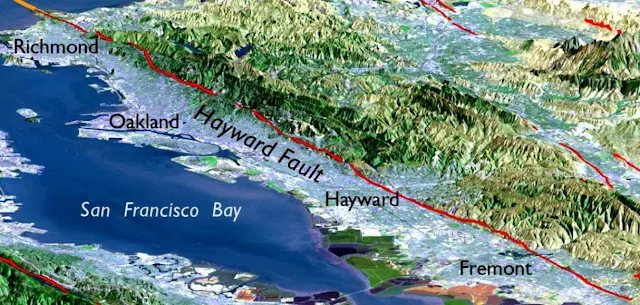Study: East Bay Fault Is 'Tectonic Time Bomb,' More Dangerous Than San Andreas
Everyone knows that California’s San Andreas fault is a ticking time bomb ready to erupt – but a new study shows that another fault right under the East Bay is far more dangerous.
What will happen when the next big earthquake hits northern California? A team of researchers including CU Boulder Professor Keith Porter will explore that question at an event today marking the anniversary of the 1906 temblor that leveled much of San Francisco.
A modern earthquake could kill 800 people and cause more than $100 billion in economic losses from the shaking and subsequent fires, according to estimates come from the HayWired Scenario, a project spearheaded by the U.S.
Porter, a professor in CU Boulder's Department of Civil, Environmental and Architectural Engineering, said that the toll of such a disaster could be huge—on par with the impact of Hurricane Katrina on the southeastern United States in 2005.
"It's fairly likely that a person living in the Bay Area today will live to see a major Bay Area earthquake," Porter said. "The HayWired scenario reveals weak points in our designs for new buildings, our existing water infrastructure, not to mention problems with fires after earthquakes and with older elevators.
"California hasn't seen a major tremor since the rise of the Internet age—the last was 1994's Northridge earthquake in the Los Angeles area. The Hayward Fault itself last ruptured 150 years ago. Scientists estimate, however, that it or another Bay Area fault will likely produce a large earthquake in the next 30 years. The HayWired scenario seeks to help the region learn from the lessons of this when-not-if event without having to experience the costs.
"We tend to improve our building codes and other aspects of our infrastructure after a big disaster," Porter said. "We learn our lessons the hard way. But what the USGS's Science Application for Risk Reduction program has found is that simulated disasters can teach us the same lessons."
To drill down on those lessons, the project team drew from a wide range of information, including diverse computer simulations, industry data and surveys of California residents. The researchers will release their findings in three volumes. The first came out last year and USGS recently published the second online. CU Boulder is a coalition partner on the project. Porter coordinated the engineering analyses for this report and performed many of them himself.
Porter's expertise hones in on the long-lasting consequences for buildings and other infrastructure. He said that while California has adopted a stringent building code, these rules focus on getting people out of buildings alive, not necessarily on making them safe for people to go back into.
But, Porter added, that there's another impact of earthquakes that often gets ignored. Drawing on data from the elevator industry, Porter estimates that the hypothetical disaster could strand roughly 20,000 people in elevators across northern California.
"That's a big deal because electricity might not come back on in parts of the Bay Area for days or more after an earthquake," Porter said. "Imagine 20,000 people trapped in a metal box for days. That's pretty scary."
Still, Porter said that many of the scary numbers that he and his colleagues reported could be addressed with relatively small investments. For a 1 percent increase in construction costs, for example, new buildings could be made 50 percent stronger.
"Big earthquakes are inevitable in California," Porter said. "There will be some very serious losses in that kind of earthquake, but some of those losses can be avoided by thinking prudently in advance."
Porter's comments are timely as the California State Legislature is currently considering Assembly Bill 1857. This bill would establish a commission that would evaluate making the state's building code even tougher, potentially ensuring the survival of more buildings after a natural disaster.
The above story is based on materials provided by USGS.









